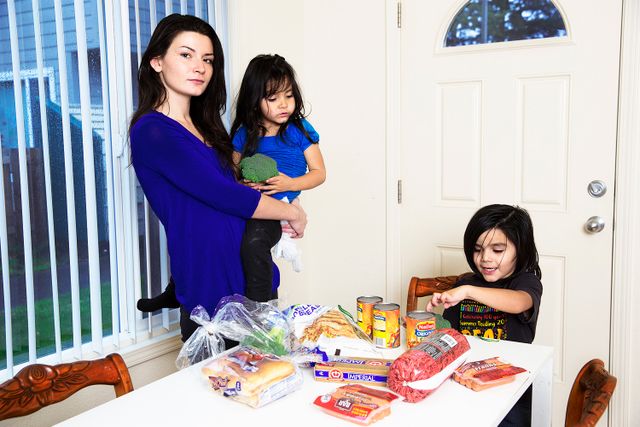On February 7, president Obama signed legislation cutting $8.7 billion from the Supplemental Nutrition Assistance Program (SNAP), also known as food stamps, over the next ten years. This latest comes on top of an across-the-board 5 percent reduction of benefits to all food stamp recipients last November.
Jennifer Noonan (24) with her children Wenona and Taima at her home in the Portland area. Jennifer saw a $49 drop in her monthly SNAP benefits after the November 2013 cuts.
In 2012, there were 49 million people in the US who were “food insecure” at some point throughout the year, according to the US Department of Agriculture, meaning that nearly 50 million individuals (including 16 million children in nearly 18 million households) “did not have access at least part of the year, to enough food for an active, healthy life.” That is, one out of five children in the United States are living in households that cannot afford enough food and do not get enough to eat.
Food insecure households in the United States, according to Joel Berg of the NY Coalition Against Hunger, are families that are forced into a position of having to ration food, or “choosing between food and rent, choosing between food and health care—parents going without meals so that they can feed their children, or children having to sometimes go through the dumpsters in the back of their school to get a meal.”
“Food insecurity is basically hunger in the American context, it’s not necessarily people starving in the streets like North Korea or Somalia,” Berg stated in a recent interview with NPR. “We’re the only major industrialized Western society on the planet that has this high a level of hunger and this high a level of poverty. And this is a country that has so many billionaires, merely only having a billion dollars doesn’t get you on the Forbes 400 list any more…so it’s incredible that even though we don’t have Somalia-type starvation, that we do have mass deprivation—and the only reason we don’t have mass third-world style starvation is because of the very nutrition assistance programs [that are being cut].” Berg continued, “The SNAP program is what keeps us [the United States] from having mass famine and starvation.”
Last November’s SNAP cuts meant that every single one of the nearly 50 million people that depend on these benefits to feed themselves and their families were hit with reductions, the average amounting to around $30 per month, with many families facing even higher cuts. The latest round of cuts from February’s legislation as part of the Farm Bill will add another $8.7 billion in slashed spending to these, which will have devastating consequences for millions of Americans, hitting particularly hard the country’s most vulnerable people: children, the elderly and disabled.
The WSWS spoke to Portland, Oregon resident Jennifer Noonan and her two young children Taima and Wenona. Jennifer, who is now 24 years old, grew up in poverty and was placed in foster care along with her sister as a child after her mother, a schizophrenic, and her father, a drug addict, were no longer able to properly care for them. She spent her teen years running away from group homes and bouncing back and forth between foster families in the Northwest and then had her first child at the age of 18. Before being placed in foster care, and even after, she has many memories of going hungry in her childhood. Before the cuts in SNAP funding at the end of 2013 she was receiving $524 per month and she is now getting $475.

 Start slideshow
Start slideshow